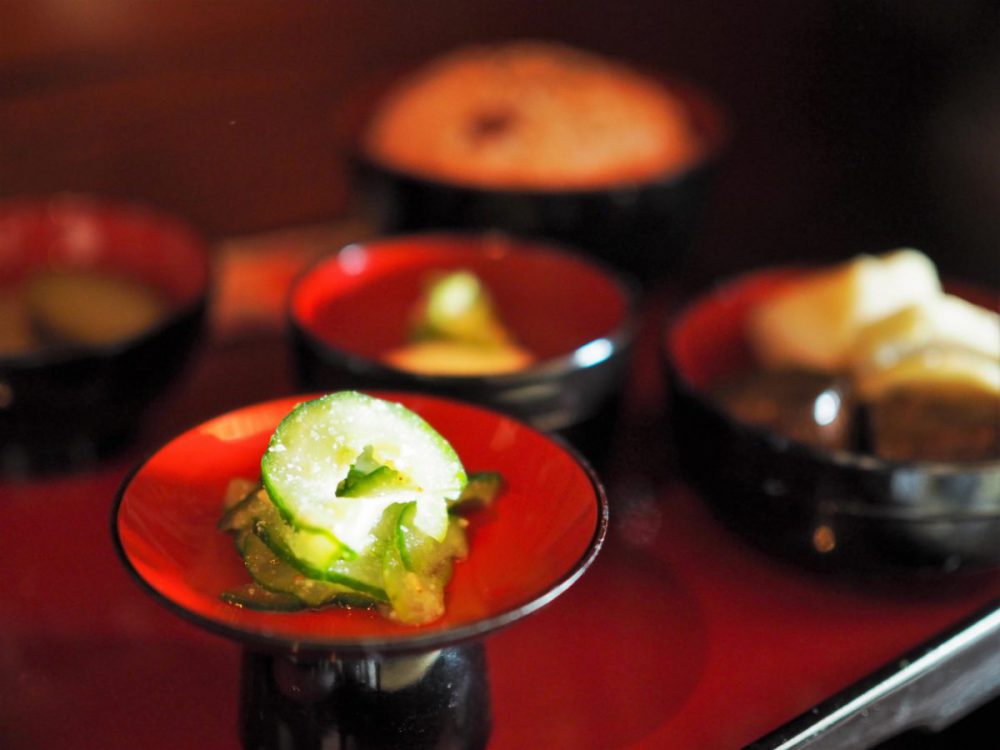A Feast For The Eyes, Stomach and The Soul

If you like Japanese food for its balanced flavours, gorgeous presentation and healthiness, then you’re going to love Shojin Ryori. Shojin Ryori is a traditional Buddhist cooking style steeped in philosophy, beauty and history. Although it is not eaten every day by ordinary Japanese people, its influence on modern Japanese cuisine is undeniable. If you visit Japan you will be able to taste it at a temple or at a restaurant.
It’s completely vegetarian and despite never using garlic or onions, it’s full of flavour. It only uses seasonal vegetables, including mountain plants. It features a variety of soy products, some of which may be new to you. This makes it a surprisingly environmentally friendly meal option. It is, of course, also fabulously healthy.

Just like chanting and meditation, cooking shojin ryori is a deeply spiritual practice. It was designed to keep the monks focused on being aware and compassionate. Because it’s vegetarian, the monk-chefs won’t ever be responsible, either directly or indirectly, for the death of any animals. This prevents them from breaking the Buddhist precept of non-violence. The monk-chefs are trained to “ichimotsu zentai”, or use everything. Veggie scraps are used to make stock, pickles or sometimes even tempura. Even eating shojin ryori is a spiritual practice if you eat it mindfully, especially focusing on the fives below! Thankfully eating it is a lot less work than shopping for and cooking it.
The Philosophy of Five
Every dish and every meal must be balanced. Each meal must have:
the five colours: green, yellow, red, black, and white;
the five flavours: salty, sour, bitter, spicy, and sweet;
the five cooking methods: boiling, baking, frying, steaming, and keeping it raw.
Every meal is served on five dishes and each dish will have a range of textures to harmonise with our five senses. There are a lot of fives to focus on, so your meal will be mindful and each dish on your tray will be so beautiful that you can’t help but gaze at it in wonder before you eat it.
Long History
When Buddhism first came to Japan in the 6th century, the Zen monks and priests who taught it also introduced their cooking philosophies and styles. In the 8th century, they also introduced tofu, not just to Japanese Buddhists but all of Japan. The monks later developed koya tofu, dried tofu, because they had a glut of soybeans in the 9th century. The monk chefs also decided to fry tofu to make abura-age, to create more variety within their meals. Natto, or fermented soybeans, is apparently another discovery of Buddhists in Japan that pre-dated tofu by a few decades. Even miso paste, which is made from soybeans, came to Japan via the Buddhist monks. All these soy products, which are all high in protein, vitamins, and minerals, plus those that are also high in probiotics, are essential to Japanese cuisine today. Their existence in Japan is all down to shojin ryori.
If you define shojin ryori just as vegetarian cooking you are focusing just on its limits. Let’s now look at its wide variety of other ingredients which might be new to you.
- yuba – tofu skin. Possibly the blandest thing you’ll ever eat but it’s surprisingly comforting.
- fu – Wheat gluten. I know lots of Aussies avoid it but it’s tasty and healthy.
- konnyaku– jelly-like substance made from taro-like potato starch. Very good for your stomach and low calorie
- hijiki– a twig-shaped sea vegetable which has its own seaweedy flavour but soaks up other flavours well
- wakame and nori – edible seaweed. You probably know nori from the outside of sushi rolls.
- konbu – edible kelp that is really high in umami flavours. This is used to make stocks so delicious you’ll swear there’s meat in them.
- shiitake – the most marvellous mushroomafter the truffle
These basic ingredients are joined by a changing and plentiful array of seasonal produce, making the best use of local, organic produce at its most flavourful and nourishing. The monk chefs look for ingredients that are locally grown and naturally abundant in each season. There are lots of mountain vegetables that are only available for a few weeks a year. These feature heavily in shojin ryori meals. I couldn’t even learn the names of many of them but I have a photo for you. The only one I can name takenoko, or bamboo shoot. The extreme seasonality of shojin ryori means that if you eat food cooked by the same chef a week or two later, much of the meal will be quite different.
You can eat shojin ryori if you are lucky enough to do shukubo, or temple lodging. Koyasan, near Kyoto, is a wonderful place, with more than a hundred temples and monasteries, to do that. Before breakfast and dinner, you might see robed monks slipping from temple to temple carrying precious shojin ryori dishes. Instead of each temple having to make 25 plus dishes, they share some of the workloads. Another, more secular way, to eat shojin ryori is to reserve a table at one of the restaurants specialising in it. Some of them even have earned Michelin stars for their extraordinary cuisine. And you won’t feel obliged to take part in meditation afterwards.
